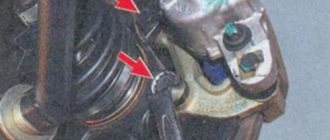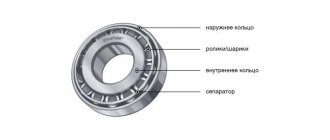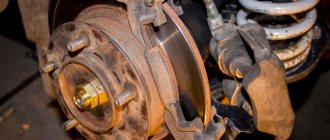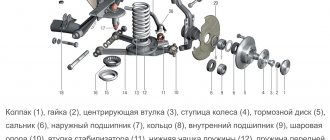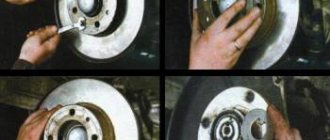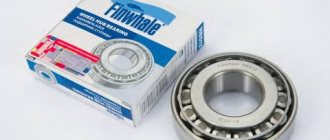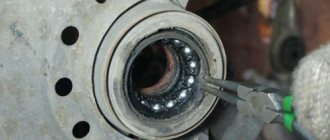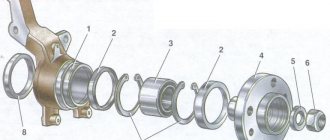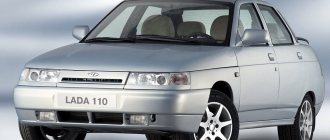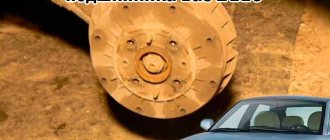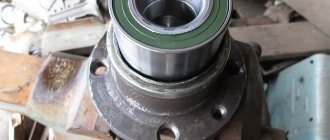The main symptom that indicates a wheel bearing problem is a characteristic hum and/or play when checking the condition of the suspension. The hum increases as the speed of movement increases, and intensifies with increasing load on the worn bearing. If such a problem occurs, the need to replace the VAZ 2114 wheel bearing is obvious.
Of course, it is better not to bring it to such a state, but to periodically change it for preventive purposes, as shown in this example. This photo report demonstrates in detail how to replace the front wheel bearing on a VAZ 2114 car with your own hands.
List of new parts and tools for replacing them
Replacing the front wheel bearing on a VAZ 2114 begins with the purchase by the car owner of the following spare parts:
- front wheel bearing (original art. 11180 – 3103020 – 04);
- front hub retaining rings (usually included in the repair kit under art. 11180 – 3101800 – 86);
- a new front hub (art. 11180 - 3103012 - 00), which will be needed if there is excessive wear of the bearing and rotation in the seat.
It is possible to carry out all the work to eliminate this malfunction without damaging other suspension parts using the following set of tools:
- tire remover;
- a set of open-end spanners from 12 mm to 24 mm;
- socket heads from 12 to 19 mm and wrenches;
- specialized wheel bearing puller;
- specialized steering wheel end remover;
- duckbills for removing retaining rings;
- carriage;
- Screwdriver Set;
- regular pliers.
The cost of work to eliminate this malfunction from official dealers (at the end of autumn 2021) ranges from 4 to 6 thousand rubles. In small private service workshops they will ask for work from 2500 to 3000 rubles. After reading the instructions below, carrying out repairs yourself will not cause big problems for the owner of a VAZ model 2113, 2114 or 2115.
What tools and materials are needed for replacement?
The main difficulty in the replacement process is dismantling the old part and pressing the new one in place. For this purpose it is better to use a hydraulic press. If you don’t have it, you should purchase a special device, you don’t need to select it, there is one on sale made specifically for VAZ- 2115.
Press-fitting device for front wheel bearing
The spare part is high-precision, made of hardened steel, and can be damaged if handled incorrectly.
In addition to the standard kit for lifting the body and removing the wheel, during the replacement process you will need:
- head at 30;
- knob;
- flat screwdriver;
- ring puller;
- open-end wrench for 12, 17, 19, 24;
- hammer;
- round nose pliers.
To make it easier to unscrew rusted bolts, it is recommended to use VD 40 for surface treatment.
How to change a bearing yourself
Before starting work, you should carefully study all its stages:
- We jack up the car from the side of the faulty bearing, remove the wheel and, having access to the lock nut of the outer CV joint, unscrew it using a 30 mm socket. It is worth considering that when subjected to high loads, the nut can be heavily tightened; in this case, the wheel is put in place, the car is released from the jack, after which we engage first or second gear in the gearbox and with great force and an elongated wrench, it can be torn off.
Next, we proceed to dismantling the brake cylinder, for which we need to unscrew the two bolts that secure it from the inside of the hub with a 17 mm wrench, and using a flat-head screwdriver, carefully pressing the pads away from the disc, we remove this unit to the side.
- We unscrew the nut securing the steering tip from the steering knuckle, and using a specialized puller, squeeze it out of its seat, then we perform a similar operation with the tip of the ball joint located at the bottom of the hub
- The upper part of the steering knuckle is attached to the suspension shock absorber strut with two bolts, the lower of which regulates the vehicle's wheel alignment, mark its position and, after unscrewing these bolts, remove the entire hub assembly. We also remove the brake disc secured with two screws.
- Using a specialized puller, we press the front hub out of the inner race of the bearing, then remove the retaining rings on both sides, and with the same puller, we squeeze the old bearing out of its seat.
- Before installing a new wheel bearing, we clean its seat from old contaminants, carefully inspect it for possible damage, small chips and cracks, and if they are found, the steering knuckle must be changed, otherwise there is a possibility of its rapid breakdown.
- We lubricate the bearing seat in the steering knuckle, which will greatly facilitate its pressing, install one retaining ring and mount the new part using a specialized puller until a characteristic click is heard, after which the second retaining ring is inserted.
- We clean, inspect for damage and, if there is none, lubricate the seat of the front hub. Then, using a puller, we carefully press it into the inside of the new bearing and mount the entire assembly into its seat. After that, we carefully insert the splined flange of the drive, install the brake disc, caliper, ball joint and steering end, after which we tighten the new nut securing the outer CV joint, which comes in the repair kit for new parts, roll its edges into the locking grooves and put the wheel in place.
This completes all work on replacing the front wheel bearing. Also watch the video for a detailed analysis of replacing the front wheel bearing on VAZ 2113, 2114, 2115 cars:
Source: autorn.ru
Removing and installing a new part
Next, using round pliers, you need to remove both retaining rings, which are located on both sides of the bearing, after which you can begin to press it out using a puller. The latter consists of two cups, which are connected to each other by a long threaded rod with a 17 mm wrench head. The rear cup has a diameter larger than the bearing race; it must be rested against the steering knuckle.
The front cup is placed on the other side of the holder, the pin is screwed in and they begin to squeeze the bearing out of its seat, turning the rod with a wrench. The latter is pressed in with an interference fit; it is often necessary to apply significant force to move the clip from its place, and this is not very convenient to do in weight. Therefore, it is better to use a lever at first. Then the race will go easier and the entire bearing will come out, the disassembly process is complete.
As for performing work in the absence of a puller, this is also possible, although replacing the bearing becomes more complicated. It is best to completely remove the steering knuckle; it is very problematic to knock out a tightly seated clip from its socket. The removed unit is secured in a vice and, using round inserts of the required diameter and a hammer, the old bearing is knocked out and a new one is installed in its place.
Before this, the seat must be thoroughly wiped with a rag, lubricated with a thin layer of thick lubricant and one retaining ring placed on the back side. Place the new bearing into the seat without distortion, attach a wooden adapter to it along the entire plane and hammer the cage into the seat with a precise blow of a hammer.
It will not be possible to do this completely using a wooden adapter when the edge of the bearing is flush with the plane of the seat; for subsequent pressing, you can use the old clip as an adapter and a hand vice. Using the latter, press the cage until it becomes possible to install the second locking ring.
After this, the steering knuckle can be put in place. Replacement using a puller is much easier. The bearing is inserted into the seat of the steering knuckle evenly, without distortion. Then the front cup of the puller is placed on it and then the work is done, as was done during extrusion.
Only now, when the key is rotated, the front cup will press the clip into the socket; do not forget to install the locking ring before doing this. After the bearing is in place, the second ring is installed and the entire suspension assembly is assembled in the reverse order. At the end of the work, it is recommended to check the front wheel alignment.
A little about the device and functionality
The main purpose of the part is to ensure uniform rotation of the car wheels. Given the name of the part, it is easy to guess that wheel bearings are the connecting link between the hub and the axle to which the brake disc and wheel are attached.
The design of the part fully corresponds to the classic type of rolling bearings. These are two metal rings into which conical rollers are pressed, protected from the body by a durable rubber insulator.
Unlike foreign competitors, domestic bearings are created using outdated HUB technology. They are quite difficult to install, require very precise tightening torque and require plenty of lubrication.
The operation of the mechanism lasts for several years. It is recommended to change a spare part for a VAZ 2114 approximately once every 100 thousand kilometers. But negative operating factors can accelerate the wear process:
Bearing diagnostics
Let's talk about how to check a wheel bearing.
An indirect sign that you need to pay attention to the bearing on the VAZ 2114 is the appearance of a characteristic hum or hum from one of the wheels while driving. Typically, the noise increases at high speeds, making it easier to hear on the highway.
The driver, being in the cabin, is not always able to correctly determine the source of the noise. For example, a hum from the left wheel may be perceived as coming from the right. Or vice versa. To accurately determine by ear where the damaged bearing is located, you need to watch how the sound changes when turning when the mechanism is subjected to a higher load. If the sound disappears when turning right, but appears when turning left, the right bearing has worn out.
Diagnostics is carried out in the following way.
- We raise the car so that the wheel being diagnosed is hanging out.
- We rock it with our hands, holding the top part.
- We turn the wheel by hand.
- Pay attention to the smooth deceleration of movement and to extraneous sounds.
- An emerging backlash may also indicate a problem.
Diagnostics of the VAZ 2114 rear wheel bearing, causes and signs of wear
Before replacing the rear wheel bearing of the VAZ 2114, it is advisable to check it every 20,000 km, then you can plan for the replacement in advance. To diagnose, we lift the car with a jack, or rather the side with characteristic signs of breakdown:
- Noise from the wheel, turning into vibration;
- The grinding sound indicates that the separator or cages have already been destroyed;
- Increased chassis play - the locknut is not tightened or the bearing has failed.
Advice:
Try tightening the locknut; if the play and noise disappear, the spare part will last for some time.
Steps to diagnose a bearing:
- Rotate the chassis in a suspended state; if you hear noise or other extraneous sound, the bearing will have to be replaced. The wheel can also slow down when turning.
- Check the wheel play by moving it axially by hand. If there is no significant play, this does not mean that the part is working properly. Since the axial clearance is checked using a special technique. Focus on point No. 1.
- To accurately determine the “diagnosis”, unscrew the bolts and check how the brake disc rotates. When the product is in good working order, rotation is easy - without jamming or noise. The video shows the noise that occurs when the chassis rotates if there is a malfunction in the hub assembly. The second video shows details of the replacement.
Rear bearing diagnostics
Replacing a VAZ rear wheel bearing without pullers
Replacement instructions
Replacing the rear wheel bearing on a VAZ 2114 is carried out as follows:
- Loosen the wheel bolts and wheel locknut before jacking up the vehicle.
- Raise the car using a jack. Tighten the hub nut completely and remove the wheel. Unscrew the mounting bolts on the drum.
- Remove the drum. If it is rusty, pre-treat the joint with WD-40. If after this the drum still does not budge, use long pins. Screw them into the holes and tighten them one by one until the part moves out of place. You can gently help with a hammer by tapping it on the back side.
- Unbend the stopper and unscrew the locknut. If it is tight, use a wrench extension.
- Using a universal puller, press the hub.
- The inner race remains on the shaft, and the outer part of the bearing remains in the housing. If you want to replace the pads at the same time, you need to remove the axle mounts.
- Now it's time to demonstrate the entire mechanism.
- As a rule, the rear part of the axle is attached to the brake shield. To dismantle you will have to use a hammer.
- Remove the wheel bearing race using a universal puller. If the brake system does not need to be changed, this operation can be performed directly on the vehicle's axle shaft.
- We place the hub on bricks or bars, as shown in the photo. Use a hammer to knock out the old rear wheel bearing.
- Be sure to remove dirt and wash the hub in gasoline. Clean the axle shaft in the same way. Use thick lubricant to treat the seating surface. Place the new bearing in the hub bore. Mounting chamfers will help avoid distortions.
- Press the bearing with your hand and press it in about 3 millimeters. Place the old bearing on top.
- Using the side of the hammer, carefully hammer the part inward. If the process is difficult, you can cool the bearing in the freezer and warm up the hub.
- Once the rear hub bearing is in place, you can install the circlip. For this purpose, round nose pliers are used. Don't forget to lubricate the axle first.
- Carefully attach the assembled mechanism to the trunnion. Be careful to avoid distortions. Then place a washer on the threads and screw on the hub locknut.
- Using a nut, press the hub onto the axle. Tightening torque: 220 N*M. Place the drum, secure it and screw the chassis.
As you can see, replacing a bearing is a rather complicated and time-consuming task. You need to have a special tool. Sometimes it’s easier to ask a car service for help.
Source: 7vaz.ru
Replacing the front and rear wheel bearings on a VAZ 2114
As practice shows, the main reason for failure of wheel bearings is their long-term operation. Over time, a kind of buzzing begins to be created, indicating wear of this element.
Such a problem cannot be called very serious, but we still strongly recommend carrying out repairs in the near future. Such work is relatively easy to do with your own hands in ordinary garage conditions.
What happens if you don't change the bearing when it hums?
If an unpleasant, suspicious hum appears when reaching a certain speed and/or entering turns, it is necessary to check the hub as soon as possible. Operating a car with a broken wheel bearing is not only harmful to the car, but also dangerous!
What happens if the wheel bearing jams? Clearly
So, if you do not change a failed wheel bearing in time, this can lead to (or simultaneously several) emergency situations:
- Additional load (vibration) on the chassis of the vehicle and its steering. This leads to a decrease in the service life of their individual parts and assemblies.
- The engine thrust and its efficiency decrease, which can also lead to an increase in fuel consumption.
- Overheating of the brake assembly may cause the brake fluid to boil. This will lead to partial and even complete failure of the braking system!
- When turning, the wheel may simply “lie down”, which will lead to loss of control over the car. At speed this can be fatal!
- If the wear is critical, the bearing may jam, causing the wheel to stop. And if such a situation occurs while driving, it can cause a significant accident!
The design of a car suspension is a rather complex technical unit. Its components are constantly being refined, changed and improved. But the wheel bearing has been and remains an invariable element of the suspension of any car. How to check an element and what are the reasons for its wear? The answers to these and many other questions are in our article today.
How to check
Before you begin replacing the front or rear bearing of your hub, we recommend that you conduct a simple check of the functionality of this unit. This will allow you to accurately determine the culprit of the malfunction and verify the real need to replace the elements.
There are two verification methods, each of which has its own nuances.
Verification method
What to do
After a long ride, touch the area of the wheel where the noise is coming from.
If the area is hot compared to the other side, the bearing needs to be replaced
Raise the car, unscrew the wheel bolts, lift the side you are checking. Rock the wheel with more force
If the sound is dull, have a second person apply the brake and repeat the procedure. If there is no noise, the bearing must be replaced
What to choose?
Rear and front wheel bearings today are produced by both domestic and foreign manufacturers. The choice, as they say, is yours.
But we still want to give some recommendations on this matter.
- Chinese analogues. We strongly advise against choosing them to repair your VAZ 2114. They are of dubious quality, although they are the most affordable. Such bearings will not be enough for a long service life.
- Imported, mainly from Europe. The price is higher compared to analogues, but the quality is at the same level. When buying imported bearings, pay attention that they are not successful Chinese counterfeits. There are many of these now, unfortunately.
- Domestic. Pay attention to the parts made by Vologda or Samara craftsmen. The quality is quite high, and the price is affordable and adequate. What you need for the VAZ 2114.
To work on replacing the element yourself, you will additionally need:
- Special puller for bearings;
- 30mm socket wrench;
- 19 and 17 mm wrenches.
Location
Since we are talking about the VAZ 2114, the first thing we will do is determine the location of the element.
On the fourteenth, the primary bearing is located on the shaft behind the oil seal.
It is noteworthy that on some gearboxes this bearing additionally plays the role of an oil seal, taking on the load together with the release bearing.
To get to the damaged transmission component, you will have to remove the transmission. When choosing a new element, be sure to check the recommendations from the instruction manual for your VAZ 2114 regarding the overall dimensions of the component.
Replacement
First, let's set priorities. If you just want to save money, so you do the work yourself without any experience, then this is a wrong decision that can lead to dire consequences. If you have experience and certain knowledge, you can safely do the repairs yourself.
In any case, we recommend watching the training video instructions, where you will be told in detail about all the nuances of such work. This way you will gain additional experience and useful knowledge.
After this, we proceed directly to the work of replacing the wheel bearings. There are several ways. We will tell you about each of them in more detail, and you will decide for yourself which option suits your skills and capabilities.
- The first method involves carrying out work without removing the steering knuckle from the car. But here you will definitely need a special puller to dismantle the bearings. The advantage of the method is that there is no need for subsequent wheel alignment adjustment. But this is the most inconvenient way. To press out and reinstall the wheel bearing, we recommend driving the car into an inspection hole.
Puller
- The second method will require removing the steering knuckle. A workbench will also be useful for removing the bearing. In this case, you will definitely break the collapse. If you don’t want to go to a service station after repairing yourself, use a couple of tricky tricks: Before removing the lower bolt of the strut and steering knuckle, apply marks;
- One mark will allow you to determine the position of the bolt;
- The second mark will be responsible for the position in the steering knuckle strut;
- During the reassembly process, try to ensure that the marks match each other as accurately as possible. This method allows you to simultaneously make adjustments to the chassis and check the condition of the components.
The third method will require removing the bearing along with the stand and dismantling it using a vice. This method is complex compared to others.
It remains to press out the element
Before work, do not forget to turn on the handbrake and place wheel chocks under the wheels to avoid accidental movement of the vehicle.
- Remove the strut, knock out the tie rod ends and unscrew the fasteners of the upper support to the body of your car.
- Position the jack so that it does not become an obstacle during operation. It all depends on your personal understanding of comfort.
- The wheel bolts are unscrewed, after which the nut of the desired bearing is removed using a 13 mm wrench.
- Using a 17 mm wrench, you dismantle the caliper, which is secured with wire to prevent sagging on the brake hose.
Algorithm for replacing the VAZ 2115 wheel bearing
- Put the car on the handbrake, support the wheels with wheel chocks.
- Break off the mounting bolts.
Do-it-yourself replacement of the VAZ 2115 wheel bearing
- Jack up the wheel and hang it up.
- Using a 30mm wrench, remove the central nut securing the hub.
Do-it-yourself replacement of the VAZ 2115 wheel bearing
- Disconnect the drive shaft CV joint from the hub, remove the caliper and disc.
Do-it-yourself replacement of the VAZ 2115 wheel bearing
Step-by-step replacement of a VAZ-2114 wheel bearing
As practice shows, the most common cause of wheel bearing failure is the too long service life of this part. Like other spare parts, bearings have a limited service life, and therefore there comes a time when they require replacement. The wear of this part is indicated by a characteristic sound resembling a hum. If such a symptom is detected, the best solution would be to replace the wheel bearing in a VAZ-2114 car.
First make sure that it is the bearing that needs to be replaced. After you have driven your car for a long time, touch the area of the wheel that is making the humming noise with your hand. If this area is much hotter than the other side of the wheel, then the bearing does need to be replaced. Another way to check is as follows. Using a jack, you need to lift the car and unscrew the wheel bolts. You only need to lift the side where the sound is coming from. The raised wheel must be rocked with great effort. If you hear a dull sound, you need to ask someone to press the brake and rock the wheel again. If the noise disappears, then the problem is in the bearing and it needs to be replaced.
Symptoms of failure
This is where the most interesting thing is - how to determine a malfunction; there are several hundred percent methods.
1) “Dry” crunch. When a wheel bearing fails, a crunching sound appears when driving. These are spherical elements rolling. They broke the clip they were in and are now not evenly distributed. You won’t confuse this sound with anything else; believe me, this sound is perfectly audible in the cabin. This is the very first symptom - as soon as such a sound appears, we immediately go to the service station.
2) Vibration. If the bearing is already well worn, then vibration should appear in both the steering wheel and the body. This suggests that the spherical elements have already worn out the bearing race well, a little more and a “wedge” may occur. We change it urgently.
3) The car is pulled to the side. It is also possible that the part with the faulty element is not working properly - so to speak, it is stuck a little, and therefore the car will pull in one direction or another, as if the wheel alignment was incorrect.
Replacement
If you do not have experience in such matters, it is better not to undertake the replacement yourself. In this case, it is strongly recommended to seek the help of a specialist. If you have ever been involved in car repairs, then you can most likely easily and quickly cope with this task yourself. In any case, it is recommended to first watch the training video instructions that you will find on this site.
The first method is that the replacement is carried out without dismantling the steering knuckle. However, you can’t do this without a puller. The main advantage of this technique is that there is no need to adjust the wheel alignment. However, this replacement method is one of the most inconvenient. To reinstall the machine, you will need to drive it into the inspection hole.
The second method involves removing the steering knuckle. In addition, replacement will require a workbench; it is needed to remove the old bearing. With such removal, the camber will be disrupted. To avoid having to go to a service station later, follow these steps during the replacement process:
- Before removing the lower strut and steering knuckle bolt, mark the position of the bolt and the position in the steering knuckle strut.
- When performing reassembly, you must ensure that the marks clearly coincide with each other.
This way you will be able to make adjustments to the chassis.
In any case, it is better to have a special device for squeezing out and pressing in the wheel bearing. The absence of a puller will significantly complicate the replacement procedure, since in this case there will be a need to disassemble and knock out parts that have failed. The tools you will need to replace the bearing are:
- ring and open-end wrenches;
- union head (for unscrewing the bearing nut);
- wheel wrench;
- jack;
- round nose pliers (for removing retaining rings);
- rags;
- gloves.
Start by disassembling the chassis. Replacing the front bearing is a simpler procedure than replacing the rear one. After you have lifted the wheel, you need to loosen the hub nuts. Remove the decorative cap and remove the boot from the socket. Place the prepared socket on the nut and loosen it using a lever and a wrench. After this, unscrew the wheel bolts and remove the wheel.
After this, you need to remove the brake caliper. To do this, unscrew the two bolts and move the caliper in any direction so that it does not interfere with further work. Secure it with rope or wire to the lower arm. Remove the brake disc.
After unscrewing the hub nut, you need to pull the front axle shaft out of the steering knuckle. To do this, unscrew the ball joint bolts. Then remove the hub itself.
Using round-nose pliers, remove the retaining rings (located on both sides of the bearing). Use a puller to press out the bearing. The rear cup must be rested against the steering knuckle. The front one should be placed on the holder.
If you do not have a puller, it is better to completely dismantle the steering knuckle. The bearing can be knocked out using a hammer and round bits. Then put the steering knuckle in place. Place a new bearing in the seat and reassemble.
Often, car owners in the process of performing this work are faced with such a problem as the inability to tighten the clip without damage. A situation may arise when the race of the old failed bearing remains on the hub or (in the case of the rear wheel) on the axle axle. To remove without damage or other negative consequences, it is best to use a two-jaw puller for these purposes.
Using the “paws” you need to hook the clip on different sides, and screw the rod in the middle. It should rest against the center of the axle axis. In this position it will be possible to pull the old bearing out of place. This type of puller is quite widespread among car enthusiasts and car service technicians. You can find it in almost any auto store.
Source: ladaautos.ru
Instructions for disassembling the chassis
Diagram of the components of the VAZ 2114 chassis
Replacing the front wheel bearing is a more labor-intensive operation than the rear one, so we’ll look at it first. Before removing the wheel, it is better to loosen the hub nut. To do this, you need to remove the decorative cap and remove the metal boot from the socket. Then put a 30mm socket on the nut and use a lever wrench to loosen it. Now you can loosen the wheel bolts and jack up the car.
Once the wheel is removed, the brake caliper prevents further disassembly. Therefore, it must be dismantled by unscrewing 2 bolts from the inside of the brake disc and first removing the pads from it. To prevent the caliper from interfering with further manipulations, you need to move it to the side and attach it to the lower arm with soft wire or rope. Now you can remove the brake disc by unscrewing the 2 studs securing it.
When the hub nut is completely unscrewed, getting to the bearing is hindered by the front axle shaft, which must be pulled out of the splined part of the steering knuckle. To do this, you will need to unscrew the two bolts securing the ball joint, then the CV joint can freely come out of its socket. All that remains is to carefully knock out the hub itself; for this it is better to use a wooden adapter and a hammer. Usually, strong impacts are not required; the hub sits in the steering knuckle without any tension and is knocked out without problems.
There is another way to remove the hub; for this, use 2 M12x1.25 bolts with a length of at least 130 mm and a removed brake disc. The bolts are passed through 2 holes in the disk diagonally and screwed into the hub, after which the latter is moved from its place with sharp jerks. The method does not always help, especially if the race of the old damaged bearing remains in the steering knuckle after pressing out, then it will still have to be unscrewed and removed from the CV joint splines.
Manual for replacing the front wheel bearing of Lada 2114
bearing The power parts connecting the front suspension units are bearings installed with interference inside the steering knuckles and on the hubs. A hum during movement, clicks when a raised wheel rotates, and axial runout are key signs indicating wear of the inner and outer rings of the support or unsuitability of the hub seating surface.
Organization of repair conditions
Convenient places for replacing the front wheel bearing on a VAZ 2114 are a lift or a pit. However, you can get less comfortable access to the necessary components on a monolithic horizontal platform.
The initial task of the performer is to open access to the steering knuckle. To do this you need:
- unscrew the hub nut located on the front wheel CV joint shaft (behind the protective cap);
- remove the wheel;
- brake caliper assembly with guides and brake pads;
- brake disk.
Method for loosening the hub nut:
- align the nut shoulders using a narrow chisel;
- tighten the handbrake;
- engage first gear;
- secure the wheel with shoes;
- Loosen the nut using a 30mm socket with a long knob (the clamping force is quite large).
Instructions for replacing the front suspension wheel bearing on a VAZ 2114 on your own
Having opened access to the hub, you should remove the previously loosened “30” nut and washer from the CV joint shaft. You can get to one side of the bearing after removing the part with the developed flange:
- select two bolts with a length of at least 130 mm with threads similar to those of the wheel fasteners (M12 x 1.25);
- pass the selected bolts through two holes in the brake disc located opposite each other;
- Using sharp forward movements, hit the bolt heads several times with the brake disc (the process of pressing the hub out of the steering knuckle).
Access to the back side opens like this:
- unscrew the two bolts at “17” with a head, fastening the ball joint flange and the steering knuckle;
- move the steering knuckle towards you;
- remove the CV joint from the steering knuckle (you will need to use a pry bar: leaning on the stabilizer bushing body
- bend the two lower suspension arms to move the ball joint away from the swivel assembly).
Alternative method for removing the hub:
- disconnect the ball joint;
- remove the CV joint from the repair unit;
- knock out the hub by hitting the rear end of the part flange with a hammer through a soft metal drift (bronze, aluminum, brass...).
The actual replacement of the wheel bearing on a VAZ 2114 is carried out according to the following method:
- Use special pliers to remove the retaining ring located inside the steering knuckle on the front side;
- press out the support using a puller;
- clean and lubricate the inner surface of the unit on which the outer ring of the bearing is based;
- press in a new bearing (using an alternative method in the form of hitting the bearing ring with a hammer is highly not recommended);
- install the retaining ring;
- press the hub into the inner ring of the support;
- Carry out the preparatory operations in the reverse order (be sure to tighten the hub nut to a torque of 225-247 Nm and bend the collars to prevent unscrewing).
Using a puller
hub The repair operation is often carried out using two types of pullers:
- cup, which is a bolt with large and small washers, a cup and a nut;
- two-legged.
Technique for handling the cup puller:
- when pressing out the wheel bearing, rotate the nut from the side of the cup: the cup rests against the end to which the flange was previously adjacent; the bolt head presses through the washer onto the inner ring of the bearing;
- when pressing a wheel bearing (the cup is not used): install a large washer on the bolt, insert the bolt into the steering knuckle (the washer rests against the rear end of the unit), install new and old bearings on the bolt, a washer that transmits force to the outer ring, and a nut (its rotate);
- when pressing the hub (the cup is not used): install a washer on the bolt that rests on the inner ring of the bearing, insert the bolt into the bearing from the rear side, install a washer that rests on the small end of the hub, mount and rotate the nut.
It happens that during the process of replacing a faulty VAZ 2114 wheel bearing, the inner ring remains on the hub. The procedure for removing it is often carried out using a two-legged puller:
- install the paws to the outer end of the rolling support ring (has the largest diameter);
- place the central screw in the end of the hub;
- By rotating the screw, remove the support ring.
Sometimes the puller is powerless in this procedure. An alternative is to use a thin chisel and hammer:
- pry off the dirt protection ring with a screwdriver;
- place a chisel between the hub flange and the end of the ring;
- Gently hit the chisel with a hammer to move and remove the ring;
- clean out the resulting nicks with a file;
- Install the dirt ring and seal.
- the dismantled ring then participates in the procedure of pressing out the bearing using a cup puller;
- it is necessary to check the suitability of the hub for further use: the new bearing should be difficult to put on.
Total
Tools needed: a set of wrenches and sockets, circlip pliers, cup and two-jaw pullers, hammer, chisel, soft metal drift, screwdriver.
A summary map of the technology for replacing the VAZ 2114 front wheel bearing looks like this:
- loosen the collars and unscrew the nut on the CV joint shaft;
- remove the wheel;
- remove the brake disc and caliper assembly;
- unscrew the ball joint housing;
- press out or knock out the hub through a “soft” drift;
- remove the CV joint;
- remove the retaining ring;
- press out the bearing;
- press in a new support;
- install the hub;
- assemble the brake system;
- install the wheel;
- tighten the hub nut and bend its shoulders.
Elements protecting hinges on front-wheel drive VAZ vehicles
The boot is a hinge protection element on front-wheel drive Zhiguli cars, made of special corrugated rubber. It is installed on the internal and external drive joints and protects them from external factors. It also holds the lubricant necessary for operation inside the joint.
Self-replacement of front bearings on VAZ cars
Hubs are an important element of a car's front suspension. When the wheel bearings malfunction, the first thing that appears is a hum, and sometimes a grinding sound, in the front wheels of the car. The hub begins to heat up, which can cause problems with the brakes. Play in the front suspension hubs leads to
Power Torque: Front Wheel Bearing Replacement
Basic concepts on how to replace a defective front wheel bearing. The list of main transitions will allow you to independently carry out this operation.
Replacing bearings yourself
Modern drivers often encounter such a problem as the occurrence of hum and various extraneous noises in the car suspension. The main reason for this is usually the presence of faults in the bearings. This means it's time to replace them. To carry out repair work
How to independently replace CV joint boots on a VAZ 2109.
CV joint boots are a front-wheel drive unit, which is popularly called a “grenade”. The reasons that lead to their damage can be different: aging of the material, hitting an obstacle, as well as careless operation of the car.
Chassis design
Front wheel bearing
Before you begin the replacement process itself, you need to see all the structural elements that need to be dismantled. Therefore, first you need to understand the structure of the front part of the suspension, or rather, look at the elements in section and determine the location of the bearing.
Front chassis design
Front suspension assembly: 1 – upper support of the telescopic strut; 2 – upper support cup; 3 – compression stroke buffer with protective casing; 4 – compression buffer support; 5 – suspension spring; 6 – lower spring support cup; 7 – steering rod ball joint; 8 – steering knuckle; 9 – telescopic stand; 10 – eccentric washer; 11 – adjusting bolt; 12 – rack bracket; 13 – steering knuckle; 14 – front brake protective cover; 15 – brake disc; 16 – retaining ring; 17 – wheel hub nut; 18 – splined shank of the wheel drive hinge housing; 19 – guide pin; 20 – wheel hub bearing; 21 – ball joint; 22 – suspension arm; 23 – adjusting washers; 24 – stabilizer strut; 25 – stabilizer bar; 26 – stabilizer bar cushion; 27 – stabilizer bar mounting bracket; 28 – body bracket for mounting the suspension arm; 29 – suspension arm extension; 30 – bracket for fastening the extension; 31 – protective cover of the ball pin; 32 – ball pin bearing; 33 – ball pin; 34 – ball pin body; 35 – suspension strut rod; 36 – outer body of the upper support; 37 – inner body of the upper support; 38 – upper support bearing; 39 – rubber element of the upper support; 40 – travel limiter of the upper support; 41 – protective cap of the upper support; B - zone for monitoring the suspension joint
